Dear Zazie, Here is today’s Lovers’ Chronicle from Mac Tag dedicated to his muse. Follow us on twitter @cowboycoleridge. Rhett
The Lovers’ Chronicle
Dear Muse,
no need to follow Kees tonight
“Will go wherever you lead”
that is where the phrase
came from, and it is
“Dark yet evocative”
was a time, everywhere
i turned it was there,
so i started goin’ in deeper
“Glad you found a way out”
still mostly there when we met
“Now for a different kind of moan”
© copyright 2023 mac tag/cowboycoleridge all rights reserved
© copyright 2021 mac tag/cowboy coleridge all rights reserved
wander through thoughts yet,
and gaze upon thy memory
where feeds countless notes,
from remembered looks,
worn by the waste of time
listen
at the close of day,
hear the story
whispered
will be the cry
a murmur
against the wail
of the lone night
© copyright 2019 mac tag/cowboy coleridge all rights reserved
like all the others
ended abruptly
takin’ chances for years
just intensified
the episodes
a blue moan
tried not to fall
but could not manage it
talked of leavin’
another country
gittin’ lost
become a mystery
“What keeps you going?”
do you know…
© copyright 2018 mac tag/cowboy coleridge all rights reserved
loneliness
to fill the void
with thoughts
happiness,
no too strong,
contentment
in dreamin’,
awakenin’
wretched
must be
livin’ without
soundin’
i shall find you,
i shall find…
can you find
what you do not know
you are lookin’ for
the promise
has no end
nightfall comin’ on,
late February, snow falls
driftin’ in piles, the wind
whippin’
across the plains
a song, playin’
a blue moan
i see now,
mapped and marred,
the trail behind
and the years ahead
hurt, madness, fear
threaten, escape, survive
may this night
open Her comfort
to these tired eyes
i look at you
across time
and darkness
and wonder
can you feel
can you hear
do you know…
© copyright 2017 mac tag/cowboy Coleridge all rights reserved
| Winslow Homer | |
|---|---|

Winslow Homer, 1880,
photo by Napoleon Sarony (1821–1896) |
|
Today is the birthday of Winslow Homer (Boston; February 24, 1836 – September 29, 1910 Prouts Neck, Maine); landscape painter and printmaker, perhaps best known for his marine subjects. In my opinion, he is one of the foremost painters of 19th-century America and a preeminent figure in American art.
Largely self-taught, Homer began his career working as a commercial illustrator. He subsequently took up oil painting and produced major studio works characterized by the weight and density he exploited from the medium. He also worked extensively in watercolor, creating a fluid and prolific oeuvre, primarily chronicling his working vacations.
As a result of disappointments with women or from some other emotional turmoil, Homer became reclusive in the late 1870s, no longer enjoying urban social life and living instead in Gloucester. For a while, he even lived in secluded Eastern Point Lighthouse (with the keeper’s family). In re-establishing his love of the sea, Homer found a rich source of themes while closely observing the fishermen, the sea, and the marine weather. After 1880, he rarely featured genteel women at leisure, focusing instead on working women.
Homer died at the age of 74 and was interred in the Mount Auburn Cemetery in Cambridge, Massachusetts. His painting, Shooting the Rapids, Saguenay River, remains unfinished.
Gallery
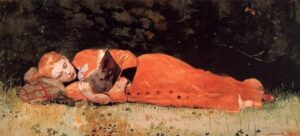
The new novel


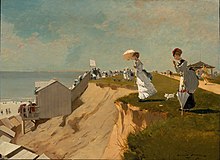





- Early landscapes and watercolors
-
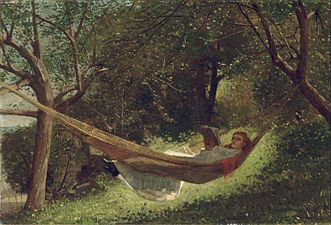
Girl in the Hammock, 1873
-

The Four Leaf Clover, 1873
-

The Green Hill, 1878
-

On the Stile, c. 1878
-

Peach Blossoms, 1878
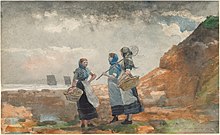
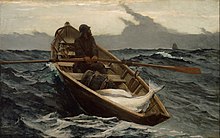

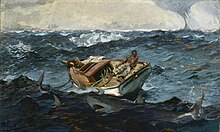

- Seascapes by Winslow Homer
-

Moonlight, 1874
-

Crab Fishing, 1883
-

The Herring Net, 1885
-

Sunlight on the Coast, 1890 (Toledo Museum of Art, Ohio)
-

Moonlight, Wood Island Light, 1894


-
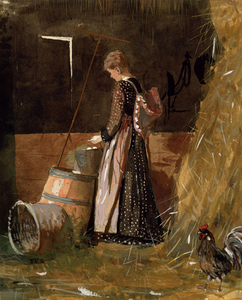
Fresh Eggs, 1874
-

Song of the Lark, 1876, oil on canvas. Chrysler Museum of Art
-

The Reaper, 1878
-

The Milk Maid, 1878
-
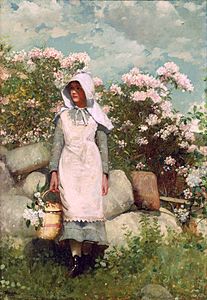
Girl and Laurel, 1879
- Pastoral landscapes
-

Bo-Peep, 1878
-

Shepherdess Tending Sheep, 1878
-

Warm Afternoon (Shepherdess), 1878
-

The Blue Boy, 1876
-

Twilight at Leeds, 1876
- Shores and beaches
-

On the Beach, 1869
-

Eagle Head, Manchester, Massachusetts, 1870
-

Dad’s Coming!, 1873
-

Clear Sailing, 1880
-

Two boys watching schooners, 1880
-

A Fresh Breeze, c. 1881
-

Girl Carrying a Basket, 1882
-

Girl with Red Stockings, 1882
-

Summer Night, 1890
-

Watching the Breakers, 1891
- Mountain landscapes
-

The Bridle Path, 1868, oil painting (Clark Art Institute)
-
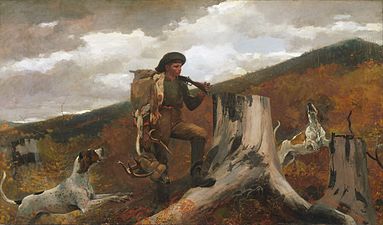
A Huntsman and Dogs, 1891
-

Mink Pond, 1891
-

The Hudson River, 1892
-

The Adirondack guide, 1894
- Croquet
-

A Game of Croquet, 1866
-

Croquet Scene, 1866
-

The Croquet Match, ca. 1869
-

Croquet Players, 1865
| Rosalía de Castro | |
|---|---|
 |
|
Today is the birthday of María Rosalía Rita de Castro (Santiago de Compstela, Galicia; 24 February 1837 – 15 July 1885 Padrón, Galicia); romanticist writer and poet.
Writing in the Galician language, after the Séculos Escuros (lit. Dark Centuries), she became an important figure of the Galician romantic movement, known today as the Rexurdimento (“renaissance”), along with Manuel Curros Enríquez and Eduardo Pondal. Her poetry is marked by saudade, an almost ineffable combination of nostalgia, longing and melancholy.
She married Manuel Murguía, member of the Galician Academy, historian, journalist and editor of Rosalía’s books.
The date she published her first collection of poetry in Galician, Cantares gallegos (“Galician Songs”), 17 May 1863, is commemorated every year as the Día das Letras Galegas (“Galician Literature Day”), an official holiday of the Autonomous Community of Galicia, and has been dedicated to an important writer in the Galician language since 1963.
Relative poverty and sadness marked her life, although she had a sense of commitment to the poor and to the defenseless. She was an opponent of abuse of authority and defender of women’s rights. She suffered from uterine cancer and died of this illness.
She is buried in the Panteón de Galegos Ilustres, a pantheon (mausoleum) in the Convent of San Domingos de Bonaval at Santiago.
Verse
¿Qué es soledad?
Para llenar el mundo
basta a veces
un solo pensamiento.
Es feliz el que soñando, muere.
Desgraciado el que muera sin sonar.
Yo te hallaré y me hallarás.
No, no puede acabar lo que es eterno,
ni puede tener fin la inmensidad
| Weldon Kees | |
|---|---|
 |
|
Today is the birthday of Harry Weldon Kees (Beatrice, Nebraska; February 24, 1914 – July 18, 1955 San Francisco); poet, painter, literary critic, novelist, playwright, jazz pianist, short story writer, and filmmaker. In my opinion, he is an important mid-twentieth-century poet of the same generation as John Berryman, Elizabeth Bishop, and Robert Lowell. His work has been influential on subsequent generations of poets writing in English and other languages and his collected poems have been included in many anthologies.
In 1948, Weldon and Ann began summering at the artist colony at Provincetown, Massachusetts on Cape Cod. In the autumn of that year, Kees had his first one-man show at the Peridot Gallery and one of his paintings was included in a group show of established and rising artists at the Whitney Museum. Despite these initial successes, however, Kees’s work only had modest sales.
Kees and Ann drove cross-country to San Francisco in late 1950.
From 1951 to 1954, Kees also made many new contacts as well as renewed old ones in the San Francisco Renaissance, among them Kenneth Rexroth and the founder of City Lights Bookstore, Lawrence Ferlinghetti. Kees’s poetry, however, did not embrace the kind dionysiac character and became increasingly sardonic and confessional in poems such as “1926.”
Verse
The porchlight coming on again,
Early November, the dead leaves
Raked in piles, the wicker swing
Creaking. Across the lots
A phonograph is playing Ja-Da.
An orange moon. I see the lives
Of neighbors, mapped and marred
Like all the wars ahead, and R.
Insane, B. with his throat cut,
Fifteen years from now, in Omaha.
from “1926”
Change, move, dead clock, that this fresh day
May break with dazzling light to these sick eyes
I look at you
Across those fires and the dark
A good night for the fireplace to be
crackling with flames – or so he figured,
Crumpling the papers he could only see
As testimonials to long plateaus of emptiness.
- The Heat in the Room
Restless and often estranged from his poetry, Kees began to collaborate with the jazz clarinetist Bob Helm in 1953 on ballads and torch songs (some written for the singer Ketty Lester).
In 1954, Kees separated from Ann, whose alcoholism led to a psychotic episode triggered by watching the Army–McCarthy hearings on television. After having her institutionalized, Kees divorced her around the time that his last book appeared, Poems, 1947–1954 (San Francisco, Adrian Wilson, 1954). He then focused on organizing a musical revue, Pick Up the Pieces, which eventually became a much more elaborate venue of literary burlesque, titled Poets Follies, which premiered in January 1955 and featured a stripper reading the poetry of Sara Teasdale.
In July 1955, Kees spent time with a woman he had met while working at Langley Porter, a Jungian psychiatrist named Virginia Patterson. Like other relationships Kees had following his divorce, this ended abruptly. Kees, too, had been taking barbiturates for the past two years, which also had intensified his episodes of manic depression. He confessed to trying to jump over the rail of the Golden Gate Bridge, but he could not physically manage it. He talked of going to Mexico as an alternative, a country that fascinated him, in books such as Malcolm Lowry’s Under the Volcano. Kees returned to his home in the Marina District on the evening of July 17, 1955. What he did the following day is a mystery. He telephoned a friend, the memoirist Janet Richards, asking her, “What keeps you going?” On July 19, 1955, Kees’s car was found deserted on the Marin County side of the Golden Gate Bridge. He was never found.
Mac Tag


No Comments on "The Lovers’ Chronicle 24 February – blue moan – art by Winslow Homer – verse by Rosalía de Castro & Weldon Kees"